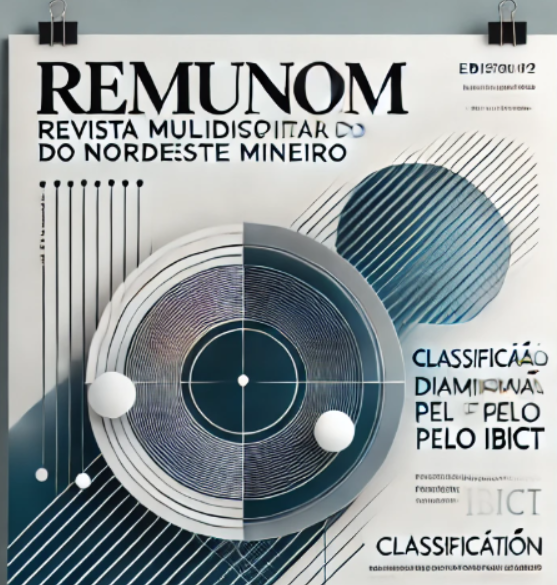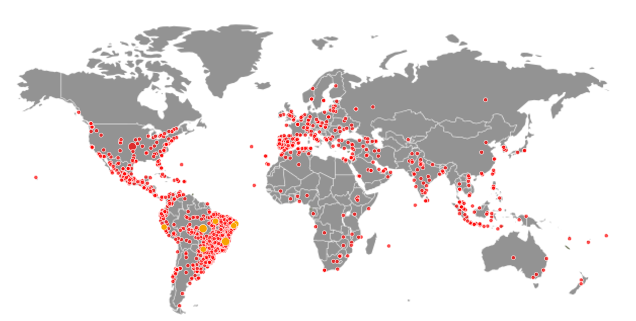VALIAÇÃO MICROBIOLÓGICA E FÍSICO-QUÍMICA DE AMOSTRAS DE ÁGUA BRUTA PROCESSADA EM SISTEMA SIMPLIFICADO DE TRATAMENTO DE ÁGUA
DOI:
https://doi.org/10.61164/csk8fw60Palavras-chave:
Água tratada, parâmetros microbiológicos, parâmetros físico-químicos, coagulantes MTH® e MT®, Rio Amazonas, Lago de Serpa.Resumo
A água desempenha um papel vital na saúde e sobrevivência de organismos vivos. No entanto, também pode ser um meio de disseminação de microrganismos patogênicos, como coliformes totais e Escherichia coli, que são indicadores de contaminação. O objetivo deste estudo foi analisar os parâmetros físico-químicos e microbiológicos da água submetida a tratamento, a fim de verificar sua potabilidade e avaliar a eficácia do processo de tratamento utilizado. Foram coletadas amostras de água bruta no Rio Amazonas e no Lago de Serpa, e análises laboratoriais foram realizadas para determinar os parâmetros de pH, turbidez, temperatura e concentração de cloro residual livre. Os resultados foram comparados com as diretrizes e regulamentações estabelecidas. O presente estudo avaliou a eficiência de dois coagulantes (MTH® e MT®) no tratamento da água bruta proveniente do Rio Amazonas e do Lago de Serpa, com base em parâmetros físico-químicos (pH, turbidez, temperatura e cloro residual livre) e microbiológicos (coliformes totais e termotolerantes). Os resultados demonstraram que, após o tratamento, os valores de pH e turbidez permaneceram dentro dos limites estabelecidos pela legislação ambiental vigente. As análises microbiológicas indicaram a ausência de coliformes em todas as amostras de água tratada, confirmando a eficácia do processo na remoção de microrganismos patogênicos. Dessa forma, conclui-se que o sistema simplificado de tratamento de água avaliado é eficiente e seguro para o consumo humano, desde que mantido o monitoramento contínuo da qualidade da água. Com base nos resultados obtidos neste estudo, pode-se concluir que o processo de tratamento da água utilizando os coagulantes MTH® e MT® foi eficaz na redução da contaminação microbiológica e físico químicas. A manutenção da conformidade com os padrões de qualidade estabelecidos é crucial para assegurar a segurança do abastecimento de água tratada. A monitoração regular da qualidade da água tratada é essencial para proteger a saúde pública e prevenir a transmissão de doenças relacionadas à água.
Downloads
Referências
APHA. AMERICAN PUBLIC HEALTH ASSOCIATION., AWWA – AMERICAN WATER WORK ASSOCIATON., WPCF – WATER POLLUITION CONTROL FEDERATION. Standard Methods of the experimination of water and wasterwater. 20. ed. Nova Iorque, 1999.
BOMFIM, A. P. D. S. Avaliação dos coagulantes Tanfloc em comparação aos coagulantes inorgânicos a base de alumínio no tratamento de água. 2015. 210f. Dissertação (Mestrado em Tecnologia Ambiental) – Universidade de Ribeirão Preto, Ribeirão Preto, 2015.
BRASIL. Fundação Nacional de Saúde. Manual prático de análise de água / Fundação Nacional de Saúde – 4. ed. – Brasília: Funasa, 2013. 150 p.
BRASIL. Ministério do Meio Ambiente. Conselho Nacional do Meio Ambiente – CONAMA. Resolução nº 357, de 17 de março de 2005. Publicada no DOU nº 053, de 18 de março de 2005. Disponível em www.mma.gov.br/port/conama/res/res05/res35705.pdf. Acesso em: 17 jul 2023.
BOFF, Leonardo. Sustentabilidade: o que é-o que não é. Editora Vozes Limitada, 2017.
CAVALHEIRO, Alexandra Lorini et al. Tecnologia de Ponto-de-Uso (POU) para desinfecção de água para consumo humano: reator UV-ozônio. 2023.
COELHO, Lúcia. Gestão de efluentes e emissões. Editora Senac São Paulo, 2020.
CORAL L.A; BERGAMASCO, R.R; BASSETTI, F.J. Estudo da Viabilidade de Utilização do Polímero Natural (TANFLOC) em Substituição ao Sulfato de Alumínio no Tratamento de Águas para Consumo Humano. In: INTERCIONAL WORSHOP ADVANCES IN CLEANER PRODUCTION, 2., 2009, São Paulo. Key elements for a sustainable world: energy, water and climate change
FRANCO, B.D.G.M.; LANDGRAF, M. Microbiologia de Alimentos. Atheneu, 2005.
FUNASA, Brasil. Fundação Nacional de Saúde. Manual de Saneamento, v. 3, 2013.
JAY, J.M. Parâmetros intrínsecos e extrínsecos dos alimentos que afetam o crescimento microbiano. In: ______. Microbiologia de alimentos. 6. ed. Porto Alegre: Artmed, 2005. Cap. 3, p. 51-72.
HANNA. Fotômetro Multiparâmetro. Hanna Instruments Brasil. 2021. Disponível em: https://hannainst.com.br/wp-content/uploads/2021/09/man_HI83399_01_20_pt_BR_v21.pdf. Acesso em: 30 jan 2023.
LKP Diagnósticos. Solução no controle de qualidade da água. [Instruções de uso do Kit COLItest®]. Disponível em: Acesso em: 17 jul 2023.
MACEDO, J.A.B. de. Águas e águas. 3. ed. Belo Horizonte: CRQ-MG, 2007.1027p.
MERTEN, Gustavo H.; MINELLA, Jean P. Qualidade da água em bacias hidrográficas rurais: um desafio atual para a sobrevivência futura.Agroecologia e desenvolvimento rural sustentável, v. 3, n. 4, p. 33-38, 2002
MINISTÉRIO DA SAÚDE. Portaria nº 2.914 de 12 de dezembro de 2011, consolidada pela Portaria nº 5, de 28 de setembro de 2017. Disponível em: https://portalarquivos2.saude.gov.br/images/pdf/2018/marco/29/PRC-5-Portaria-deConsolida----o-n---5--de-28-de-setembro-de-2017.pdf. Acesso em: 17 jul 2023.
PEREIRA, A. M., RAMOS, A. M. Determinação De Variáveis Físico-Químicas Da Água Do Lago De Serpa No Município De Itacoatiara/Am. Anais Da Semana Nacional de Ciência E Tecnologia ICET/UFAM e IFAM (ISSN 2594-8237). Itacoatiara -AM. 2022
PIVELI, Roque Passos. Tratamento de esgotos sanitários. Brasil: S/I, 2004.
SANTOS, C. N. R., RAMOS, A. M. Uso de diferentes coagulantes à base de tanino para tratamento de águas superficiais com elevada carga de sólidos em suspensão. 2020. Pibic (Programa de Iniciação Científica). Universidade Federal do Amazonas. 2020.
SILVA, Jarlan Lucas dos Santos. Isolamento, seleção e caracterização de bactérias com potencial na biodegradação do atrazina. 2022.
SILVA, G. A. D., Nunes, I. C., SILVEIRA, J. O. D. P., & LIMA, M. M. D. Preservando o meio ambiente: usando racionalmente os recursos hídricos(2024).
SILVA, E.F.; SALGUEIRO, A. A. Avaliação da qualidade bacteriológica de água e poços na Região Metropolitana de Recife-PE. Rev. Hig. Alim. São Paulo, v.15, n.90/91,2007, p. 70.
SILVA, J. O.; CAPUANO, D. M.; TAKAYANAGUI, O. M.; JUNIOR GIACOMETTI, E. Enteroparasitoses e onicomicoses em manipuladores de alimentos do município de Ribeirão Preto. Revista Brasileira de Epidemiologia. São Paulo, v. 8, n. 4, p. 385-392, 2005. DOI: https://doi.org/10.1590/S1415-790X2005000400007
SILVA, Everton Grassi da et al. Estudo microbiológico das matérias-primas e produtos de alimentos secos e desidratados. 2018.
SOUZA, M. M. DE; GASTALDINI, M. C. C. Water quality assessment in watersheds with different anthropogenic impacts. Eng. Sanit. Ambient. v.19, n.3, P. 263-274, 2014. DOI: https://doi.org/10.1590/S1413-41522014019000001097
SUZUKI, Y. HASHIMOTO, R., XIE, H; NISHIMURA, E; NISHIYAMA, M; NUKAZAWA, K; ISHII, S. Growth and antibiotic resistance acquisition of Escherichia coli in a river that receives treated sewage effluent. The Science of the Total Environment, v. 690, p. 696–704, 10, 2019. DOI: https://doi.org/10.1016/j.scitotenv.2019.07.050
TORTORA, G. J., FUNKE, B.R., CASE, C.L., Microbiologia. Porto Alegre: Artmed. 6° Ed. 2005.
Downloads
Publicado
Edição
Seção
Licença
Copyright (c) 2025 Revista Multidisciplinar do Nordeste Mineiro

Este trabalho está licenciado sob uma licença Creative Commons Attribution-NonCommercial-ShareAlike 4.0 International License.
Autores que publicam nesta revista concordam com os seguintes termos:
- Autores mantém os direitos autorais e concedem à revista o direito de primeira publicação, com o trabalho simultaneamente licenciado sob a Licença Creative Commons Attribution que permite o compartilhamento do trabalho com reconhecimento da autoria e publicação inicial nesta revista;
- Autores têm autorização para assumir contratos adicionais separadamente, para distribuição não-exclusiva da versão do trabalho publicada nesta revista (ex.: publicar em repositório institucional ou como capítulo de livro), com reconhecimento de autoria e publicação inicial nesta revista, desde que adpatado ao template do repositório em questão;
- Autores têm permissão e são estimulados a publicar e distribuir seu trabalho online (ex.: em repositórios institucionais ou na sua página pessoal) a qualquer ponto antes ou durante o processo editorial, já que isso pode gerar alterações produtivas, bem como aumentar o impacto e a citação do trabalho publicado (Veja O Efeito do Acesso Livre).
- Os autores são responsáveis por inserir corretamente seus dados, incluindo nome, palavras-chave, resumos e demais informações, definindo assim a forma como desejam ser citados. Dessa forma, o corpo editorial da revista não se responsabiliza por eventuais erros ou inconsistências nesses registros.
POLÍTICA DE PRIVACIDADE
Os nomes e endereços informados nesta revista serão usados exclusivamente para os serviços prestados por esta publicação, não sendo disponibilizados para outras finalidades ou a terceiros.
Obs: todo o conteúdo do trabalho é de responsabilidade do autor e orientador.







